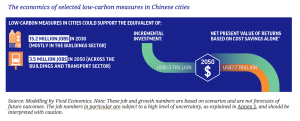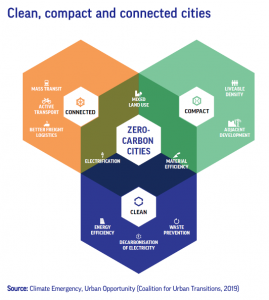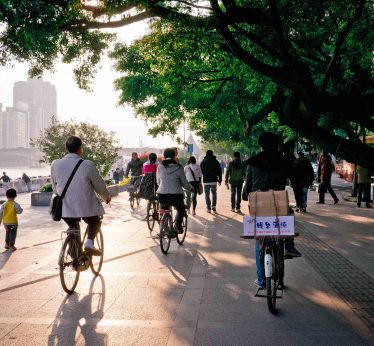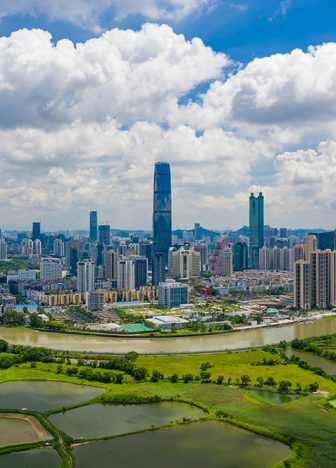China’s development strategy has been remarkably successful, driving one of the most significant economic transformations the world has ever seen. Urbanisation has played a critical role. China’s cities power 90% of its GDP and continue to grow – by 2050, 4 of 5 Chinese are expected to live in cities.
But in 2020, this rapid urbanisation and development was put on hold when China was the first country to suffer from the COVID-19 pandemic and related economic crisis. China’s economy still grew 2.3% in 2020, and though this growth rate was much lower than that of recent years, it is a better performance than the contractions recorded by many other countries. However, China’s CO2 emissions grew in 2020, and its consumption of coal, oil and natural gas all increased.1https://www.carbonbrief.org/analysis-chinas-co2-emissions-surged-4-in-second-half-of-2020
At the same time, inequality in China has increased, and the concentration of production in coastal megacities has exacerbated severe pollution and environmental degradation. China also faces significant natural disaster risk that could undermine its poverty reduction and future growth.
China is particularly at risk for typhoons and flooding with over 13% of its population in coastal zones less than 10m above sea level. Ninety-two percent of these are in urban areas. Changing weather patterns, heat waves and severe droughts are also expected to reduce water availability in parts of China, with implications for agriculture, food security and energy.
As China faces these simultaneous and interconnected challenges, the coming weeks and months offer a critical opportunity for action on social wellbeing, climate change and the economy – with cities at the centre.
On the cusp of the COP26 Climate Change Conference, China’s continued leadership in climate action can grow its economy and support the international community in reaching global climate ambitions. In 2020 China made historic commitments to tackle the climate emergency, with President Xi Jinping announcing a pledge to peak emissions before 2030 and to reach carbon neutrality by 2060. The recent October 2021 guidelines to cut China’s reliance on fossil fuels to below 20% by 2060, along with other defined targets, are a welcomed step to reach these goals.
China’s newly-released NDC charts a path toward peaking by 2030 and net zero by 2060, with a reduction of its emissions intensity per unit of economic output by more than 65%. It aims to do this through expansion of hydropower, energy storage, energy efficient new construction and transport powered by clean energy.2Hook, L., Olcott, E. and White, E. “China unveils new climate plan as UN chief warns on targets.” Financial Times, October 26, 2021. https://www.ft.com/content/bb5e8f78-59bd-4327-9710-6dce1a42088f However, China’s plan does not reduce reliance on coal beyond previous commitments, and comes at the same time as indications of pressure to increase the power sector’s coal consumption amid the country’s worst on-going energy crisis in decades. The plan also promotes natural gas and non-conventional fossil fuels, which remain sources of carbon dioxide.3Stanway, D and Xu, M. “China issues plan to hit carbon emission peak before 2030.” Reuters, October 26, 2021. https://www.reuters.com/business/cop/china-cabinet-issues-action-plan-reach-carbon-emission-peak-before-2030-2021-10-26/ Continued reliance on coal and natural gas risks locking in unsustainable infrastructure, which will have to be replaced, and could counteract China’s own strides towards peaking and carbon neutrality.
China’s cities offer the national government an opportunity to address climate and economic aims. Our research shows that major investments in low-carbon cities have some of the highest potential to unleash new economic activity, create local jobs, build resilience, increase public health outcomes and set cities – and countries – on a path of prosperity and sustainable long-term development.
Recent analysis from the Coalition for Urban Transitions finds that a collection of currently feasible, low-carbon measures and investments in Chinese cities could cut emissions from urban buildings, materials, transport and waste by close to 50% in 2030 and nearly 90% in 2050, making a significant contribution towards China’s 2060 carbon neutrality goal.
These low-carbon measures would require incremental investments of US$5.5 trillion to 2050, but yield returns with a net present value of at least US$7.7 trillion over the next three decades. They could also support more than 15 million new jobs in 2030, mainly in building energy efficiency.

China can seize this moment of opportunity to steer its urbanisation towards an ecologically sound green growth pathway by prioritising low-carbon investments to build smart infrastructure, creating healthier cities, enhancing energy efficiency and promoting the development of advanced low-carbon technologies and innovative business models.










